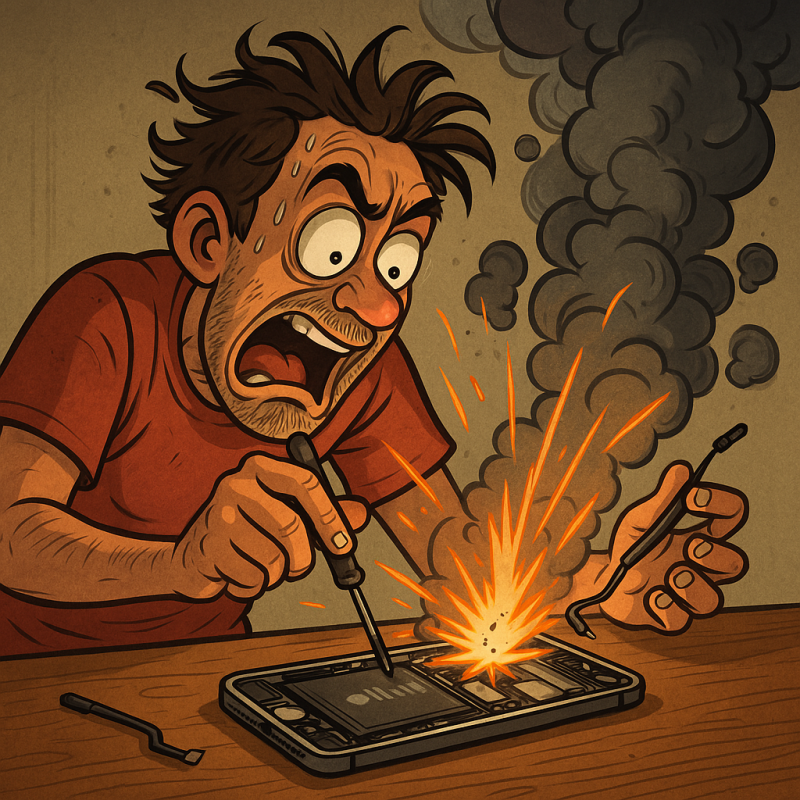Table of Contents Show
If you’ve ever dropped your iPhone, cracked your screen, or dealt with a battery that barely lasts an hour, you’ve probably considered repairing it yourself. With the rising costs of professional repair services and the abundance of DIY guides online, more people than ever are turning to self-repair as a way to save money and learn a valuable skill.
But while it can be satisfying (and cheaper) to fix your iPhone at home, it’s also a process riddled with pitfalls. A single misstep can turn a simple screen replacement into a nightmare involving fried logic boards, broken connectors, or a phone that just won’t turn on again. And unfortunately, iPhones aren’t exactly designed to make your repair journey smooth – many of the internal parts are delicate, tightly packed, and require precision and care.
So if you’re diving into the world of iPhone repair, congratulations! But before you pick up a screwdriver, there are a few important “don’ts” you should be aware of. These aren’t just helpful suggestions – they’re crucial guardrails that can save your phone, your wallet, and your sanity.
Let’s get into the most important mistakes to avoid when repairing your iPhone.
1. Don’t Use Excessive Force
One of the most common mistakes beginners make when repairing an iPhone is applying too much pressure when removing or reassembling components. iPhones are packed with tiny, fragile parts that don’t respond well to brute strength. If something isn’t coming apart easily, there’s a good chance you’re missing a screw or using the wrong technique – not that it just needs “a little extra push.”
Let’s take the battery connector as an example. This small piece links your battery to the logic board, and it’s held down by a tiny clip. If you try to pry it off with force, you risk lifting the socket off the board entirely – a catastrophic move that can render the phone useless or require expensive micro-soldering to fix. Similarly, trying to yank off the screen with too much enthusiasm can crack the display or tear a flex cable, both of which are costly mistakes.
Tip: Use a plastic spudger or opening pick to gently ease components apart. If something feels stuck, stop and double-check your disassembly guide. Forcing it is rarely the right answer.
2. Don’t Skip Steps in Your Guide
iPhones are engineered with a level of precision that leaves no room for shortcuts. Every step in a proper repair guide is there for a reason – whether it’s removing a bracket, disconnecting a cable, or applying adhesive. Skipping even a small step can cause problems down the line.
Let’s say you skip removing a protective shield because it “doesn’t seem necessary.” You might get away with it, or you might end up bending a connector or breaking a fragile cable underneath. Worse still, if you forget to reattach a grounding screw or leave a cable unsecured, your phone could have intermittent issues like no audio, a non-functioning camera, or random shutdowns.
Tip: Follow detailed guides from trusted sources like iFixit or YouTube technicians with high ratings. Keep track of screws and parts – iPhones have different screw sizes, and mixing them up can damage internal threads or pierce the battery.
3. Don’t Ignore Safety Precautions
Repairing electronics isn’t just a matter of knowing which screw goes where – it’s also about protecting yourself and your device from accidental damage. This is especially true when it comes to electrostatic discharge (ESD) and short circuits.
Always disconnect the battery before working on anything. It might seem harmless to start prying around the motherboard with it still connected, but one slip of your tool could cause a short that permanently damages the board. That mistake could turn a $50 battery swap into a $400 logic board replacement – or worse, an entirely bricked phone.
Also, don’t overlook the importance of ESD safety. Static electricity from your clothes or carpet can destroy sensitive components in the blink of an eye, even if you don’t feel a zap. Anti-static mats and wristbands are affordable and easy to use.
Tip: Make it a habit to power off the phone and disconnect the battery as your first step. Work on a clean, grounded surface, and wear an anti-static wristband if possible.
4. Don’t Rush the Repair
Time and patience are your best allies during any repair. Rushing through steps because you’re eager to get your phone working again often leads to costly mistakes. It’s easy to overlook a loose screw, forget to reconnect a cable, or misalign the screen when you’re trying to beat the clock.
Let’s say you finish a screen replacement in 20 minutes and feel pretty proud – until you realize your Face ID no longer works. That’s often because a small flex cable at the top of the phone was improperly reconnected or torn during hasty reassembly. Now you’re dealing with a far more complex and expensive issue, all because of impatience.
Tip: Give yourself plenty of time. Lay out your tools in an organized manner, label screws if needed, and don’t skip the final inspection before reassembly.
5. Don’t Attempt Repairs Beyond Your Skill Level
There’s a big difference between replacing a cracked screen and trying to repair a water-damaged logic board. Some repairs, like battery or screen swaps, are beginner-friendly with the right tools and guidance. Others – like micro-soldering or component-level repair – require serious expertise and equipment.
If you find yourself watching a video that involves using a microscope, a soldering iron, or detailed motherboard diagnostics, ask yourself if you really have the skill (and nerve) to do it right. Taking on a repair that’s too advanced can leave your phone worse off than when you started – or even permanently dead.
Tip: Know your limits. If a repair guide starts to sound like an electrical engineering class, it might be time to bring in a pro. You can always learn and practice on a dead phone before attempting something risky on your main device.
Bonus: Other Mistakes to Avoid
Here are a few more quick “don’ts” to keep in mind during any iPhone repair:
| Mistake | Why to Avoid It |
|---|---|
| Don’t use metal tools near the battery | Metal can short the battery and cause sparks or fire. Stick to plastic pry tools. |
| Don’t forget to test before closing | Always test the phone before sealing it up to avoid having to open it again. |
| Don’t ignore weird smells | A burning smell could indicate a damaged battery – stop immediately. |
| Don’t use random adhesive | Cheap adhesives may not hold the screen properly. Use OEM or high-quality replacements. |
| Don’t forget your waterproofing | If your iPhone had a waterproof seal, make sure to replace it properly or you’ll lose that protection. |
Conclusion: Fix Smart, Not Fast
Repairing your iPhone can be incredibly rewarding. Not only do you save money, but you also gain confidence and a sense of accomplishment from restoring your own device. But like any technical skill, it demands respect, attention to detail, and a willingness to learn.
Avoiding these “don’ts” is just as important as following the “dos.” Be gentle. Be precise. Be safe. And most importantly, be honest with yourself about your capabilities.
There’s no shame in handing your iPhone over to a professional if the job is beyond your skill level – what matters is that your device gets the care it needs without turning a small fix into a major disaster.
Take your time, work smart, and happy fixing!









